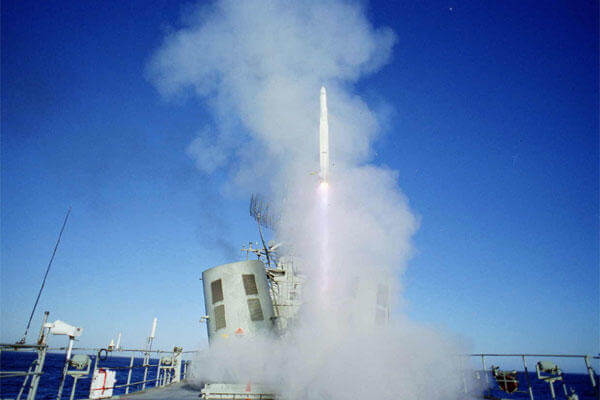The Navy is working on a $1.6 billion technological upgrade overhauling ship defense systems onboard amphibs and aircraft carriers to include interceptor missiles, streamlined radars and software improvements, service officials said.
The work is being done on what's called Ship Self Defense Systems, or SSDS – a series of integrated technologies being upgraded to track, identify and destroy a wide range of possible threats such as incoming enemy supersonic missiles.
"I'm upgrading the SSDS to handle the Joint Strike Fighter and to handle higher threats. My primary upgrades with SSDS are getting an upgrade to be able to handle supersonic targets," said Rear Adm. Peter Fanta, director of Surface Warfare.
Some of the key elements to the upgrade include getting the ship ready for upgraded missiles such as the Evolved Sea Sparrow Missile Block 2, or ESSM Block 2, and Block 2 of the Rolling Airframe Missile, or RAM Block 2.
Both missiles, already in limited or early production, are engineered to protect carriers, amphibious assault ships and other vessels from cruise missiles, small boat threats and airborne enemy threats such as aircraft or UAS.
The new RAM Block 2 variant includes a new RF receiver, new navigation system and increased diameter to 6-inches, Raytheon officials said. The weapon has a dual mode RF and IR guidance system. The Block 2 missile is 9.45 feet long, weighs 194-pounds and is able to reach supersonic speeds, according to Raytheon and Navy information.
The new missile variant also includes enhanced guidance algorithms and a more powerful dual-thrust rocket motor enabling the missile to reach longer ranges, Raytheon officials said. Overall, the Navy plans to acquire at least 502 RAMs between 2015 and 2019, service officials said.
The Evolved Sea Sparrow Missile Block II, or ESSM, is a new version of an existing Sea Sparrow weapons system currently protecting aircraft carriers, destroyers, cruisers, amphibious assault ships and other vessels against anti-ship missiles and other surface and airborne short-range threats to ships, Navy officials said.
Related Video:
The ESSM Block II is engineered with what's called an active guidance system, meaning the missile itself can achieve improved flight or guidance to its target by both receiving and actively sending electromagnetic signals, said Raytheon officials.
The ESSM uses radar technology to locate and then intercept a fast-approaching target while in flight. The use of what's called an "illuminator" is a big part of this capability, Raytheon officials said.
The current ESSM missiles use what's called a semi-active guidance system, meaning the missile itself can receive electromagnetic signals bounced off the target by an illuminator. The ESSM Block 2's "active" guidance includes illuminator technology built onto the missile itself such that it can both receive and send important electromagnetic signals, Navy and Raytheon officials explained.
"Block 2 relieves us of the requirement to do a lot of illuminator guidance as a short range self-defense. It has an active front end. That gives the fleet more options as there are going to be situations where you are going to want a semi-active guided but when you are dealing in a tough threat situation," Rear Adm. John Hill, Program Executive Officer, Integrated Warfare Systems, told Military.com in an interview.
The missile is able to intercept threats that are close to the surface by sea-skimming or diving in onto a target from a higher altitude, Navy officials explained. The so-called kinematic or guidance improvements of the Block 2 missile give it an improved ability to counter maneuvering threats, Navy and Raytheon officials said.
ESSM Block 2 is being jointly acquired by the U.S. and a number of allied countries such as Australia, Canada, Denmark, The Netherlands, Norway and Turkey. All these countries signed an ESSM Block II Memorandum of Understanding, or MOU, designed to solidify the developmental path for the missile system through it next phase. The weapon is slated to be fully operational on ships by 2020.
As part of the SSDS overhaul, Navy leaders are now working on a wide range of software and hardware fixes to amphibs and carriers so that they can accommodate the upgraded RAM and ESSM missiles.
"From a combat systems perspective I am updating the software to be able to handle the speed and the ranges that those missiles can now function against. It is both software and hardware. I also have to upgrade the Sea Sparrow launchers to take the added weight of the Sea Sparrow Block 2, upgrade the RAM launchers to take the new RAM systems and I have to upgrade the radar to allow the data to flow back and forth," Fanta said.
Fanta explained that a lot of the work relates to making sure the upgraded RAM and ESSM missiles can properly integrate into their missile tubes.
"I'm doing something within the software or the actual hardware of these systems. A lot of it is algorithm work and a lot of it is making the launchers able to turn faster with more weight in each missile tube," Fanta added.
The upgrades are also integrating a defensive weapon called Close-In-Weapons-System or CIWS, Navy leaders explained.
"It is a close-loop fire protection system all by itself. It has a radar and it has a gun. It is trainable and you can do different levels of integration with CIWS. It is either stand alone or it has some level of integration with the other sensors on board," Hill said.
Hill also explained that the current SSDS upgrades included a technology known as Fire Control Loop Improvement, or F-CLIP, which involves the use of a common display system for different sensors and radar signals.
-- Kris Osborn can be reached at kris.osborn@military.com
Don't Miss a Single Military.com Story
To read the full article and get exclusive benefits, sign up today.
It’s FREE
Why am I seeing this? Visit our FAQs





























